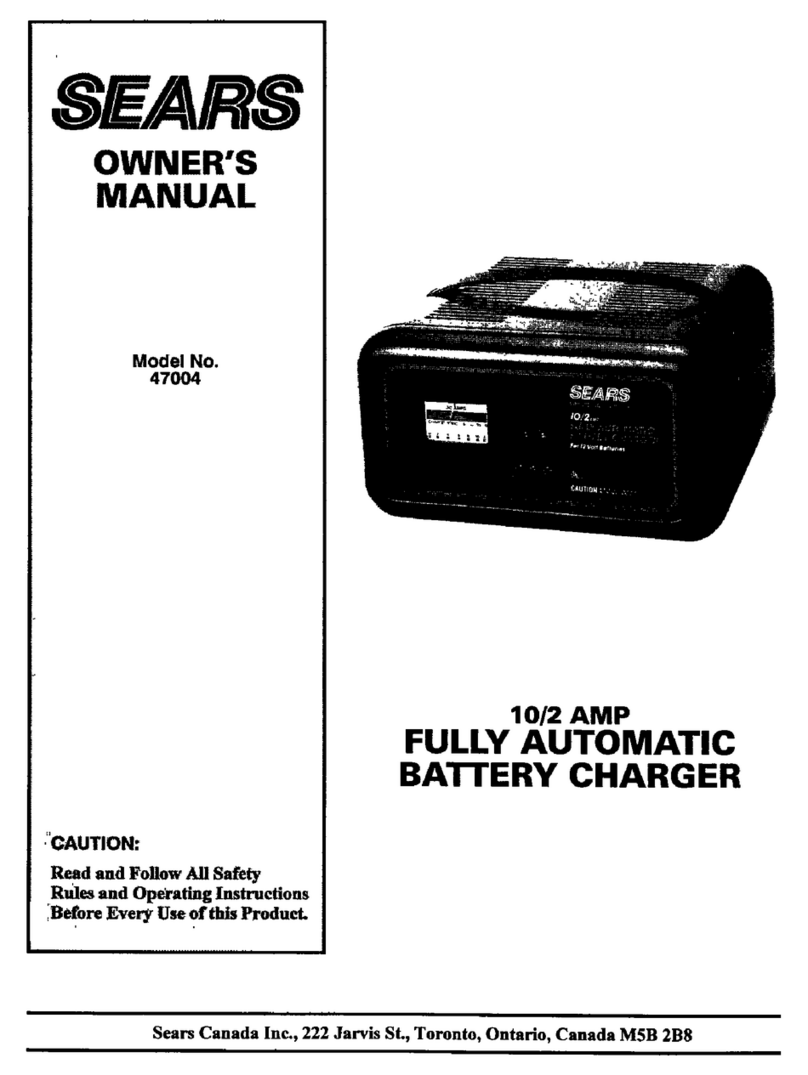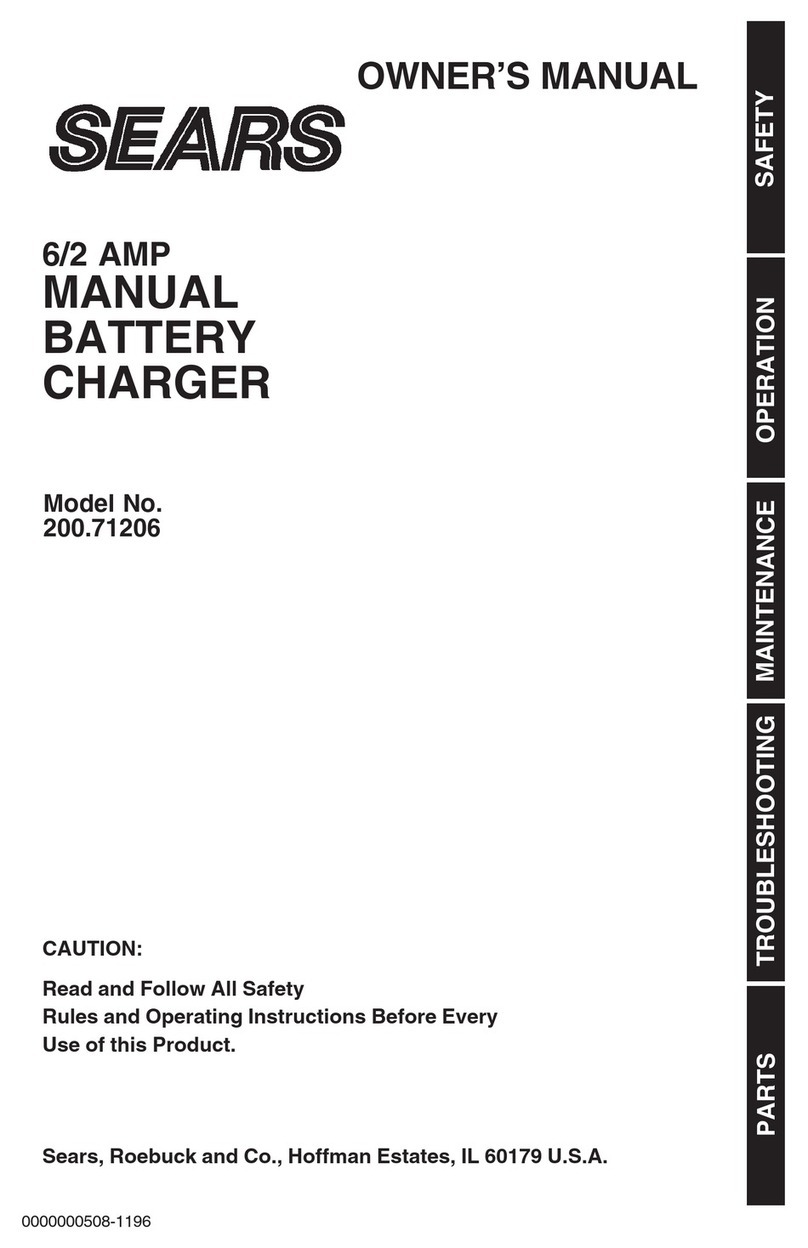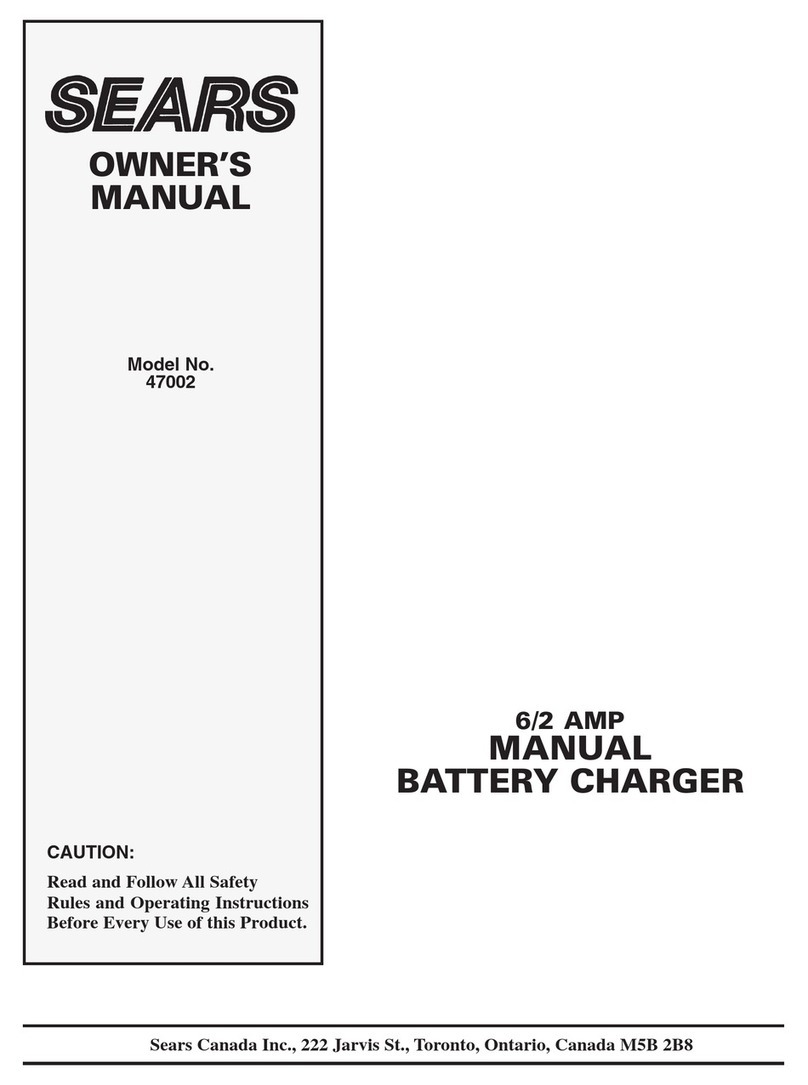Sears 200.71202 User manual

8EE/ S
OWNER'S
MANUAL
Model No.
200.71202
CAUTION:
Read and Follow All Safety
Rules and Operating Instructions
Before Every Use of this Product.
1.5 AMP
FULLY AUTOMATIC
ONBOARD
BATTERY CHARGER
MAINTAINER
Sears, Roebuck and Co., Hoffman Estates, IL 60179 U.S.A.

Table Of Contents
Warranty ................................................................... 1
Important Safety Instructions .................................. 2
Before Using Your Battery Charger ........................ 3
Plugging it in.......................................................... 3
Extension cords ..................................................... 3
Using Your Battery Charger .................................... 4
What to expect from your charger ........................ 4
Installing the charger ............................................ 4
Preparing your battery to be charged ................... 5
Charging your battery .......................................... 5
Charging indicators .............................................. 6
Maintenance and care .......................................... 6
Please read this Owner's Manual before using your Battery Charger
The Sears model 200.71202 Fully Automatic Onboard Battery Charger/Maintainer, offers features to accom-
modate the needs for home or light commercial use. This manual will show you how to use your charger
safely and effectively. Please read and follow these instructions and precautions carefully.
Warranty
FULL TWO-YEAR WARRANTY
If,withintwoyears from the date ofpurchase, thisbattery chargerfails due toa defect inmaterials orworkmanship,
simplyRETURN IT TO THE NEAREST SEARS STORE INTHE UNITED STATES, and Sears willrepairor replace
it, free of charge.
This warranty gives you specific legal rights, and you may also have other rights whichvary from state to state.
Sears, Roebuck and Co., Dept 817WA,
Hoffman Estates, IL 60179

Important Safety Instructions
- SAVE THESE INSTRUCTIONS -
•Read all instructions and cautions pdnted on the
battery charger, battery, and vehicle or equipment
using battery.
• Use charger only on lead-acid type rechargeable
batteries, such as those used in cars, trucks, trac-
tom, airplanes, vans, RV's, trolling motors, etc.
This charger is not intended to supply power to
a low voltage electrical system other than in an
automotive application.
•Use only attachments recommended or sold by
manufacturer. The use of attachments not recom-
mended by the manufacturer may result in fire,
electric shock, or injury.
• Do not disassemble charger. Take itto a qualified
service professional if service or repair is required.
Incorrect assembly may result in fire or electrical
shock.
• To reduce risk of electrical shock, unplug the
charger from the outlet before attempting any
maintenance or cleaning.
Help us help you
Remember:
• Place charger as far away from battery being charged
as the charger cables will permit.
•Never charge a frozen battery. If battery fluid (electro-
lyte) becomes frozen, bring battery intoa warm area
to thaw before you begin charging.
•Never allow battery acid to drip on charger when
reading specific gravity or filling battery.
•Never set a battery on top of the charger.
•Never place charger directly above battery being
charged.
•Never use charger for charging dry-cell batteries that
are commonly used with home appliances. These
batteries may burst and cause personal injury.
• Never operate charger if it has received ahard blow,
been dropped, orotherwise damaged. Take itto a
qualified professional for inspection and repair.
• Never pullout the plug by the cordwhen unplugging
the charger. Pulling on the cord may cause damage
to the cord or the plug.
•Do not operate the charger if ithas a damaged
power cord or plug. Have the cord replaced.
•Never crank engine with charger attached to battery
and 120 volt line.
Personal Safety Precautions
For your own personal safety, please follow the following
precautions:
•Wear complete eye and clothing protection when
working with lead-acid batteries.
•Be sure that someone is within range of your voice
to come to your aid if needed while you work with or
are near a lead-acid battery.
•Have plenty of fresh water and soap nearby for use
in case battery acid contacts your eyes, skin, or cloth-
ing. if this happens, wash immediately with soap and
water. Then get medical attention.
•Avoid touching your eyes while working with a
battery. Acid particles (corrosion) may get into your
eyes. If this occurs, flush eyes immediately with
running cold water for at least ten minutes. Then
immediately get medical attention.
•Remove all personal metal items from your body,
such as rings, bracelets, necklaces, and watches
while working with a lead-acid battery. A battery can
produce a short circuit current high enough to weld
a ring (or the like) to metal, causing a severe burn.
• Take care not to drop any metal tool or metal object
onto the battery. This may spark or short circuit the
battery or another electrical device that may cause an
explosion.
•Always operate your battery charger in an open, well
ventilated area.
•Never smoke or allow a spark or flame in the vicinity
of the battery or engine. Batteries generate explosive
gases.
• Neutralize any acid spills thoroughly with baking soda
before attempting to clean up.
2

Before Using Your Battery Charger
It is important to understand your charger's requirements. This section will tell you about your charger's electrical
requirements and how to prepare abattery for charging.
Plugging it in
Electrical Shock Hazard
Be sure that the power cord fits properly into the
outlet. If not, have a qualified electrician installa
proper outlet. Never alter the AC cord or plug
provided. Improper connection can result in
electrical shock.
Your charger should be grounded to reduce the risk
of electrical shock.
Your charger is equipped with an electrical cord that has
an equipment grounding conductor and a grounding
plug designed to be used on a 120 volt circuit.
The cord must be connected to an outlet that has been
properly installed and grounded rn accordance with all
local codes and ordinances.
ATEMPORARY adapter may be used to connect the
charger to a two-pole outlet ifa properly grounded outlet
is not available. Use the adapter ONLY untila properly
grounded outlet can be installed by a qualified
electrician.
DANGER: Before using an adapter as illustrated, be
certain that the center screw of the outlet plate is
grounded. The green colored grounding clipof the
adapter must be attached by a screw to a properly
grounded outlet. If unsure whether outlet isproperly
grounded, contact a professional electrician. If
necessary, replace the original outletcover screw with a
longer one that will secure the grounding clip to the
outlet cover and make a ground connection to the
grounded outlet.
®
Extension cords
Improper extension cords present a risk of fire or electric
shock. Follow these guidelines for using an extension
cord:
•The pins on the charger's power cord must fit firmly
into the extension cord, and the extension cord
must fit firmly into the receptacle.
•Use only 3-conductor (grounded) extension cord
when necessary.
• The extension cord must be properly wired and in
good electrical condition.
•The wire size must be large enough for its length
as specified in the following chart.
MINIMUM RECOMMENDED EXTENSION CORD
Length of Cord, in Feet 25 50 100 150
AWG* Size of Cord 18 18 18 16
"AVVG=American 'Wire Gauge
3

Using Your Battery Charger
For best results from your battery charger, learn to use it properly. This section tells how to installthe charger and
how to charge a battery in or out of the vehicle.
What to expect from your charger.
Your charger is designed for use with 12-volt batteries
only. It has a control circuit designed to stop the
charging process when a battery reaches full charge.
This same circuit requires that a battery have at least 1
volt of charge to start the charging process.
Completely discharged batteries must be brought to this
minimum state-of-charge before this charger will
operate.
The charger is designed to:
• maintain the charge level of 12-volt batteries used in
seasonal or special-purpose vehicles or engines
stored for long periods such as RVs, farm and
construction equipment, snowmobiles and the like.
• improve 12-volt battery performance during cold
weather.
Installing the charger
Location
Your charger can be mounted on a sheet-metal fender
well near the battery.
The charger comes with a two-piece mounting bracket,
two bolts, and two nuts. Position the charger on the
selected location to be sure that the leads reach the
battery terminals.
Mounting
Figure 1 illustratesthe charger mounting brackets.
Figure 2 illustrates surface mounting of the charger to the
fender well. ifusing the nut and bolt provided, drill two
holes between 3/16" and 1/4" in diameter. (For alignment
of holes use one of the brackets as a template.) Ifthe
backside of the mounting surface is hard to reach, you
may consider using two 1/2" sheet-metal screws instead
of nut and bolt, drill a pilot hole if required, drill holes
between 1/8" and 5/32". CAUTION: Do not drill or punc-
ture battery.
Electrical installations - Route and secure supply cord and
output wiring away form gas line, carburetor or other hot,
sharp or moving and pinch parts to avoid damage to the
insulation. Secure the AC cord and plug to a cable or
frame using a self locking cable tie or equivalent.
J
I"
Figure I
Figure 2
Table of contents
Other Sears Batteries Charger manuals
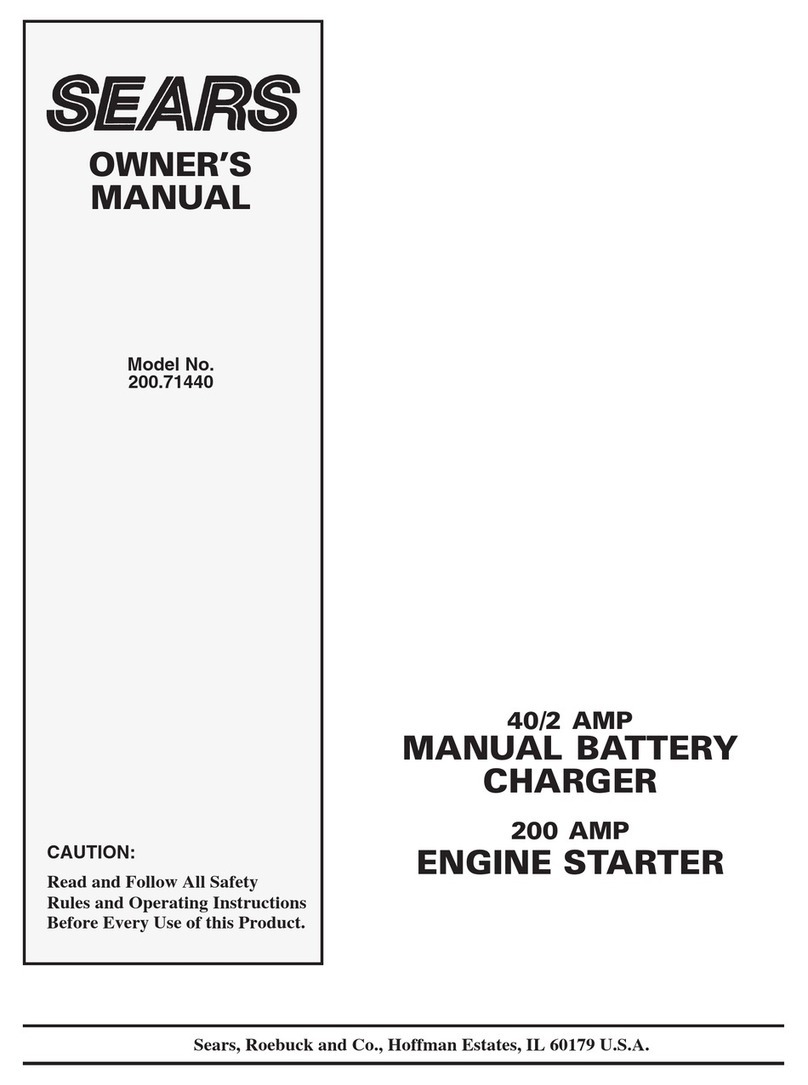
Sears
Sears 200.71440 User manual

Sears
Sears 200.7121 User manual
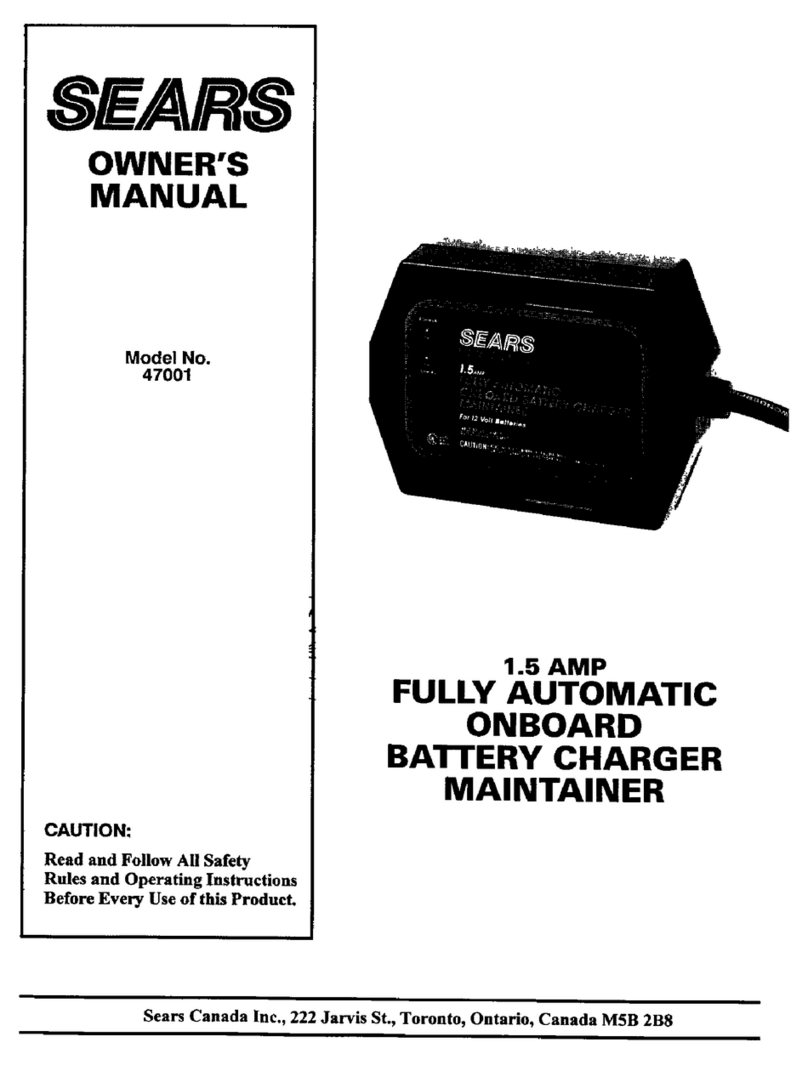
Sears
Sears 47001 User manual
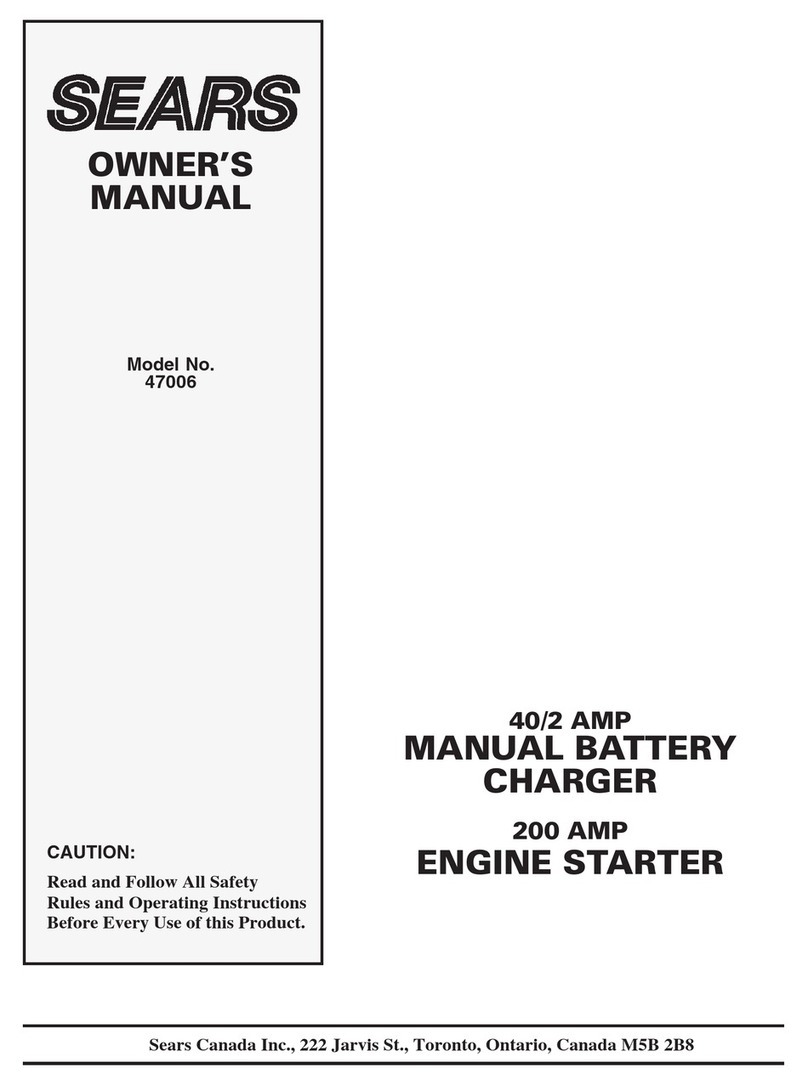
Sears
Sears 47006 User manual
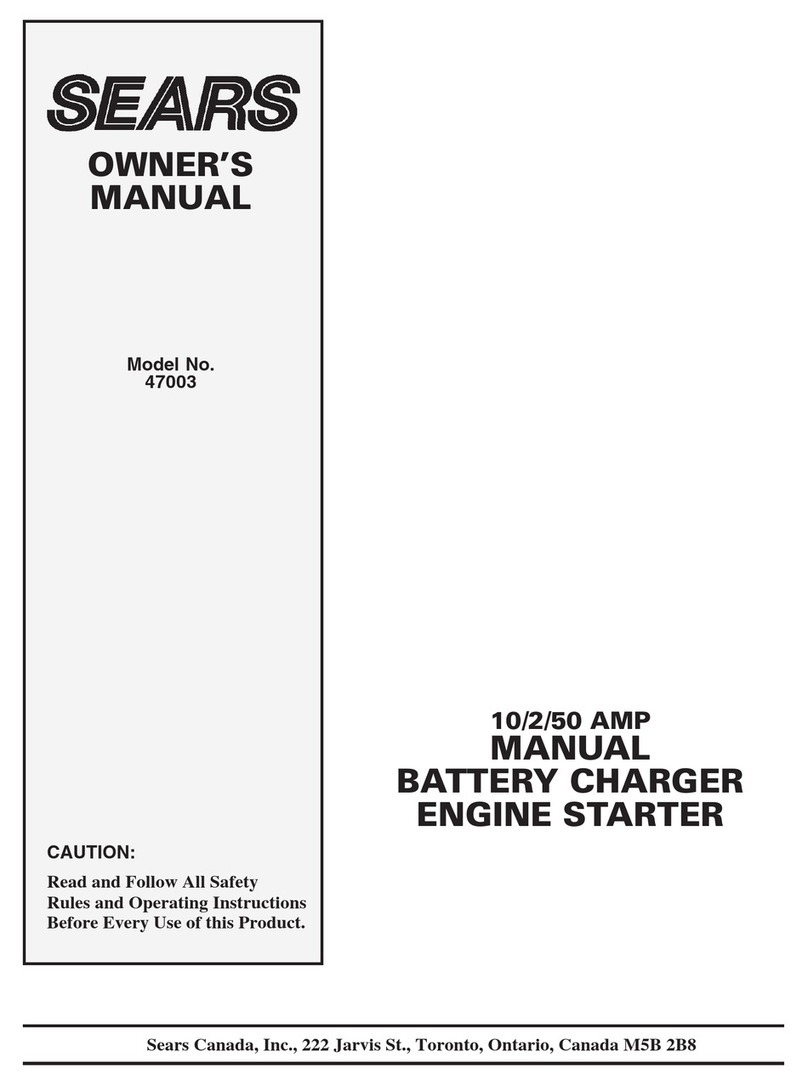
Sears
Sears 47003 User manual
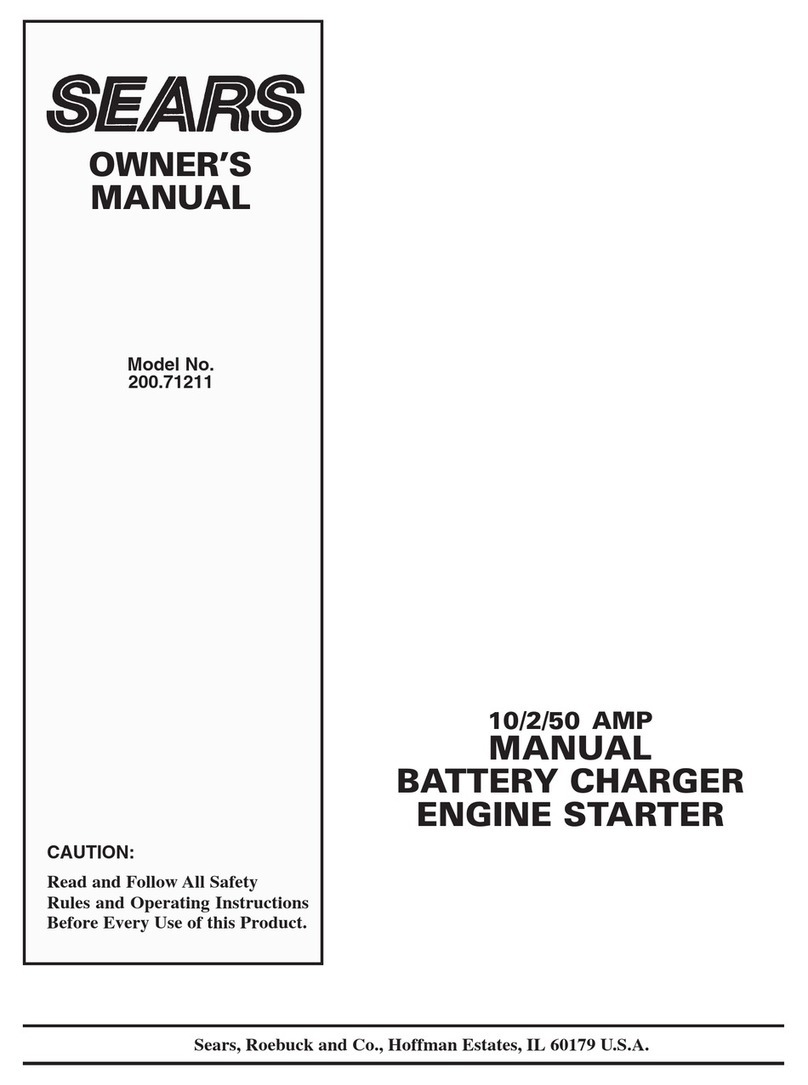
Sears
Sears 200.71211 User manual

Sears
Sears 200.71201 User manual

Sears
Sears 608.50306 User manual

Sears
Sears 200.71210 User manual

Sears
Sears 200.71206 User manual

